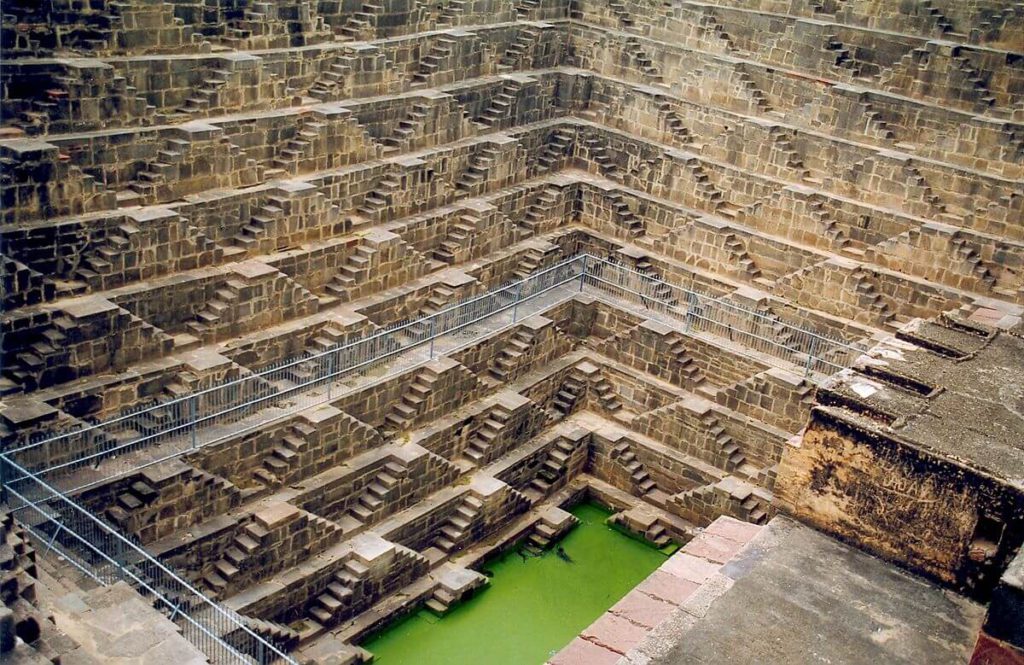The traditional sources of water in Rajasthan include Nadi, Tanka, Johad, Bandha, Sagar, Samund and Sarovar. The large public wells known as Kohar, Jhalra, Baori, Beri, Saagar were owned by the community.
Lakes/Talaab
In Rajasthan traditionally, maximum conservation of water is in the form of lakes. Few of the lakes in Rajasthan that are world famous lakes include Lalsagar (1800), Kailana (1872), Takhatsagar (1932), and Ummedasagar (1931) Balsamand lake of Jodhpur; Jaisamand, Udai Sagar, Fateh Sagar, Rajsamand and Pichhola of Udaipur; Anasagar lake, Pushkar lake of Ajmer and Mansagar lake of Jaipur . These lakes conserved large quantities of water which is used for drinking, religious and recreational purposes.
A reservoir area of less than five bighas is called a talai; a medium sized lake is called a bandhi or talab; bigger lakes are called sagar or samand.
Bawari
In Rajasthan, Step wells are locally known as Bawari and jhalara. These are sweet water aquifers getting a regular recharge through rain water. Bawaris were mainly set up in cities and big towns to provide a water supply to the community through conservation of rain water. Bawaris and Sarovar have remained important sources of drinking water and irrigation respectively since ancient times.
Naadi & Pokhar
One of the oldest and still prevalent storage structure for rainwater harvesting is naadi or dug-out village pond or tank (Pokhar). Their Agor (catchment area) is also large. The water stored in a naadi acts as a source of groundwater recharge through seepage and deep percolation and is generally used for drinking by livestock and human beings. Naadi construction is more prevalent in the western Rajasthan.
Tanka
The tanka is circular or rectangular shape pond with a life span of 3-4 years, normally on bare ground to which surface runoff can be diverted. The area around it is a clean catchment. The traditional tanka is constructed with lime plaster and thatched with bushes. Ranisar and Padamsar tanks of Jodhpur, forest tanks of Ranthambore, Sukhsagar Tank and Kalasagar tank and Padmini tank are few famous ones.
Khadeen
It was first developed in the 15th century in the Jaisalmer district, Khadeen is a most multi-purpose method of water conservation. The run-off from upland and rocky surfaces is collected in a khadeen from the adjoining valley against an embankment having a masonry water barrier for outflow of runoff excess. The standing water in a khadeen assists continuous groundwater recharge. On the Khadeen bed at least one crop is cultivated even in the arid region as it retains moisture and contains fine and fertile soil. In the immediate vicinity downstream the sub-surface water is extracted through bore wells.
Kui
To minimize the wastage of water, small well known as Kui or Beri is constructed near a water leaking and oozing tank. At Bikaner, Jaisalmer and Jodhpur ‘Kui’ are found in a large number. Its opening is covered by strips of wood and mostly they remain kaccha. Kuis or beris are normally 5 metres (m) to 12 m deep. Six or ten of kui’s when constructed together constitute a PAAR System. Rainwater harvested through PAAR technique is known as Patali paani.
Jhalras
The water of Jhalras was used in religious ceremonies, community bath and such other functions. Jhalras in Man Mandir at Jodhpur are well known. They do not have their own catchment area rather, the water reservoirs receive water from soakage of tanks or lakes situated at a higher level.
Johad
Johads are small earthen check dams that capture and conserve rainwater, improving percolation and groundwater recharge. Starting 1984, the last sixteen years have seen the revival of some 3000 johads spread across more than 650 villages in Alwar district, Rajasthan.
Traditional Roof-Water Harvesting
The houses in western Rajasthan during ancient times were constructed with stone and lime and the roof water was diverted to Tankas. The housing complexes and institutional buildings in urban areas have large roofs and the roof-top rainwater can be conserved and used for recharge of groundwater. Here an outlet pipe from the roof top to divert the water to the existing wells or special recharge wells in urban areas.


